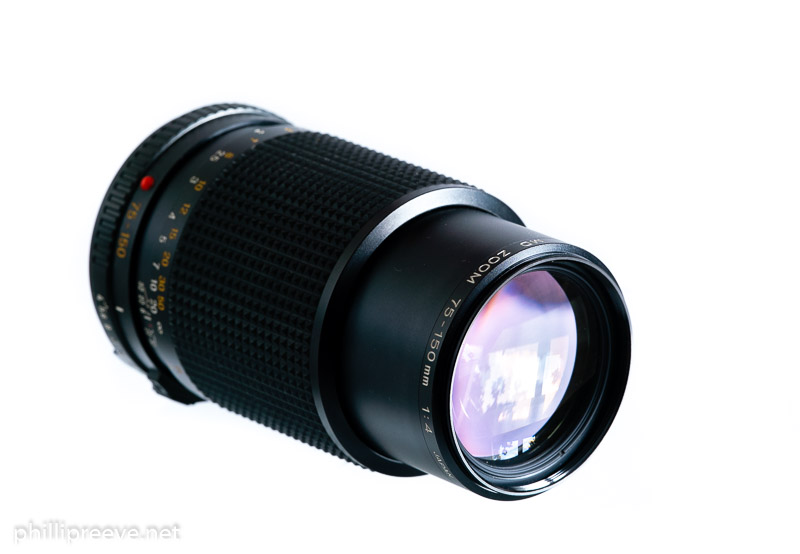
The Minolta MD 75-150mm f4 was released nearly 40 years ago but still it makes a good argument for a category of lenses which has nearly died out: Zooms with a limited range and slower speed.
Image Samples
You can find most images shown in the review in full resolution in this You can find many of the images shown here in full resolution in this flickr set: Minolta MD Zoom 75-150mm 1:4.. 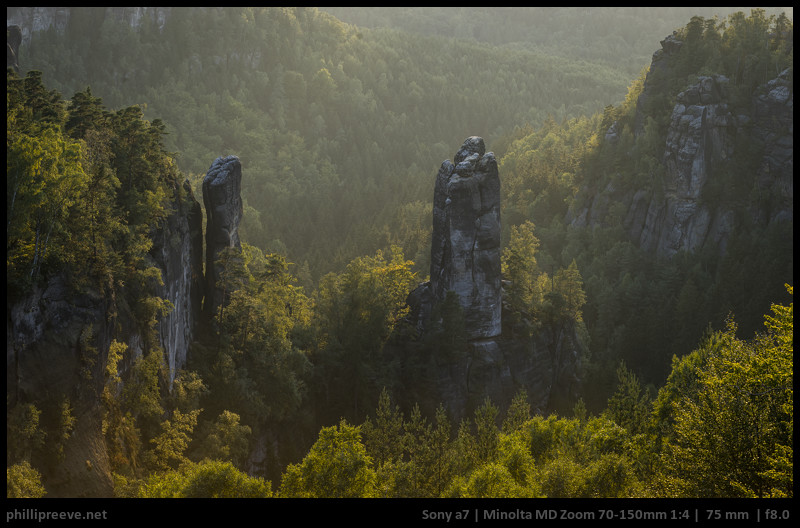
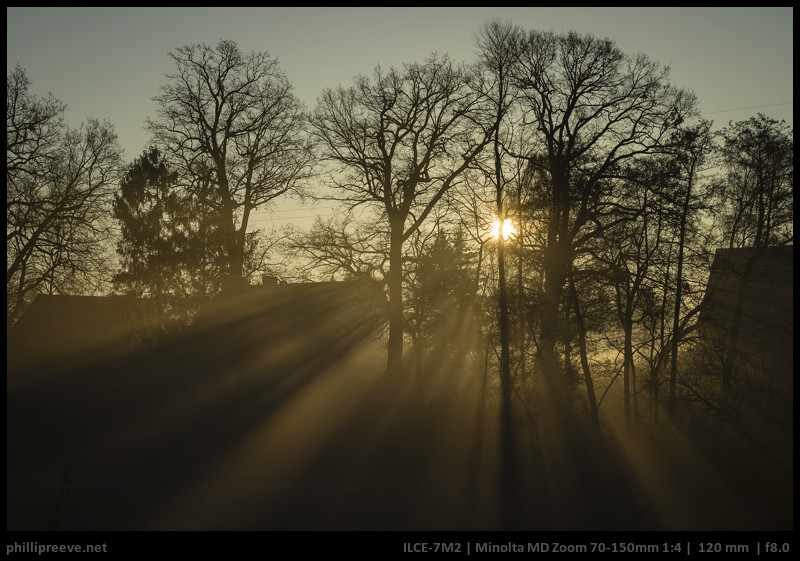
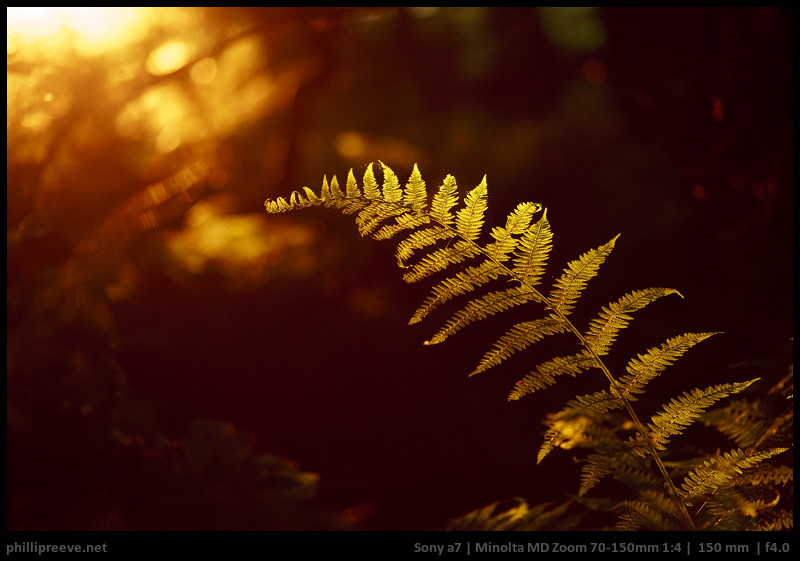
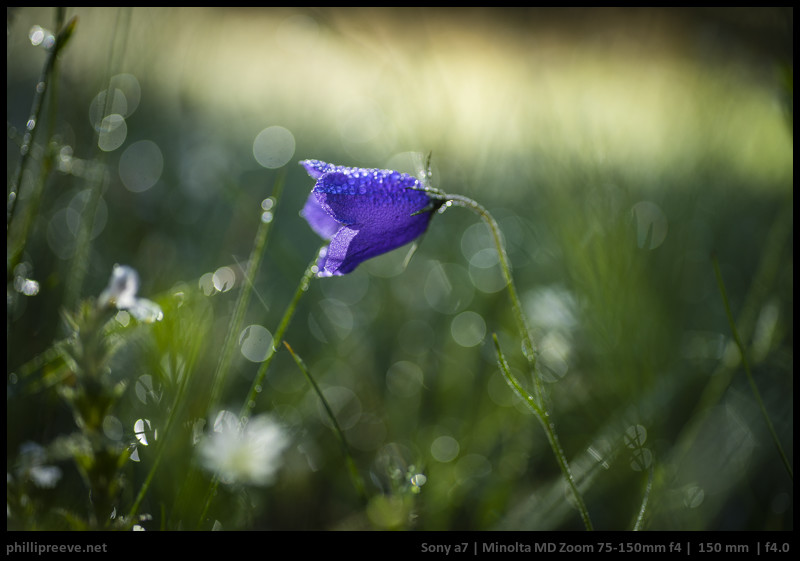

Contents
Specifications
| Diameter | 63.6 mm |
| Length | 114.7 mm |
| Filter Thread | 59 mm |
| Weight | 438 g |
| Max. Magnification | 0.17 |
| Close Focusing Distance from the sensor | 1.2 m |
| Number of aperture blades | 6 |
| Elements/ Groups | 12/8 |
Versions
There is just one version of the Minolta MD Zoom 75-150mm 1:4 which was release in 1981 at the end of the SR-mount era.
Build quality and handling
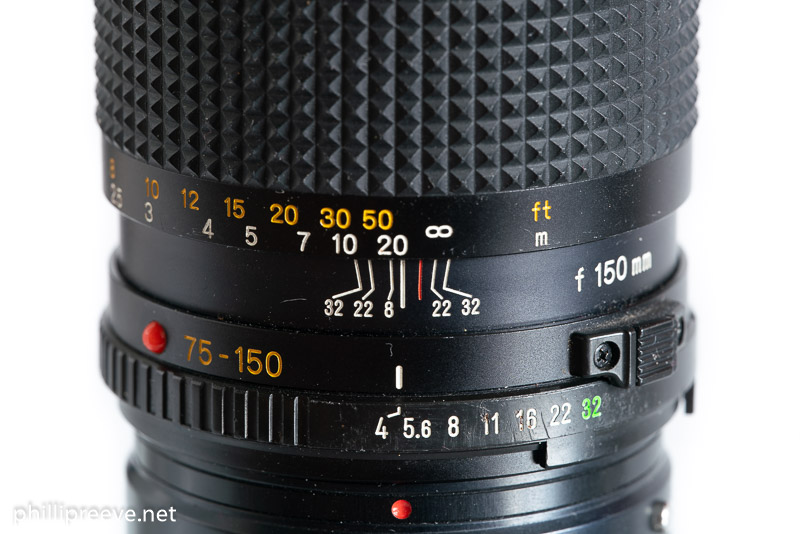
By today’s standards the Minolta 4/75-150’s build quality is very good. If you compare it to earlier Minolta MC lenses though it feels not quite as nice. The barrel is made of metal, the focus ring is rubberized and has aged very well on my copy.
The MD 4/75-150 is a push-pull zoom. Because of the limited speed and zoom range that isn’t too annoying but still these have died for good reason. The focus and zoom ring turns with proper resistance but at least on my copy it is a little scratchy. Itring travels about 180° from 1.2 m to infinity.
The aperture ring can be adjusted in half-stops from f/5.6, down to f/32.There is no stop between f/4 and f/5.6. The aperture ring is made of plastics an has gathered quite a few scratches on my copy, unlike the rest of the lens. It also feels a bit tacky but the stops are distinctive.

Size and Weight
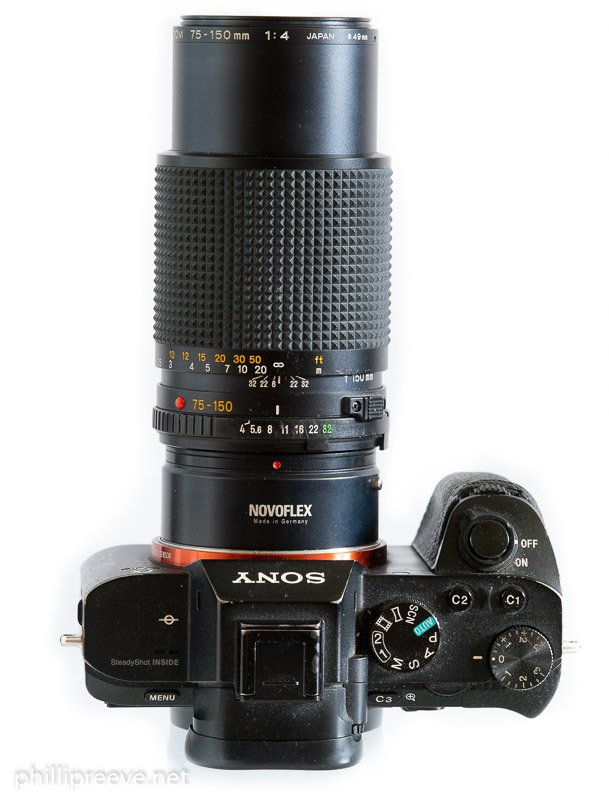
At 438g the Minolta MD 75-150mm f/4 is one of the lightest zooms I have ever used. It weights about half as much as a contemporary 4/70-200. It is also a lot smaller. That is one of it’s biggest strengths to me.
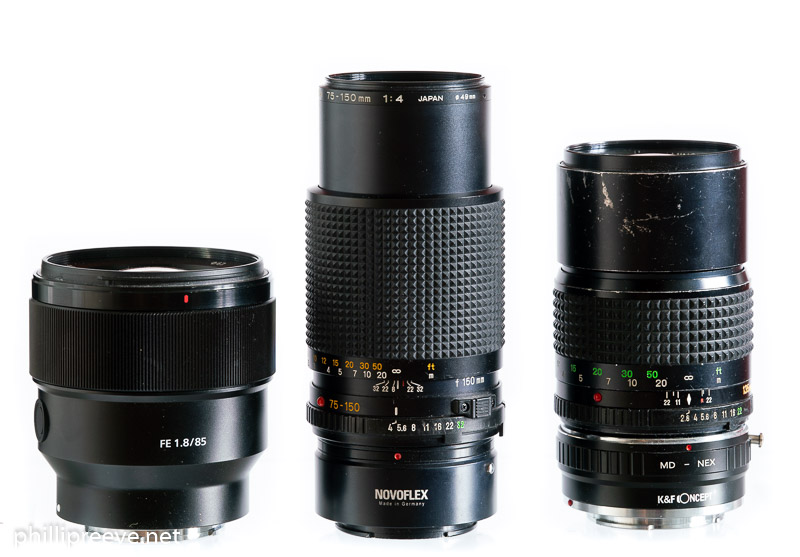
Optical performance
These results are based on the use with a Sony a7II and a7rII.
Flare Resistance
Minolta lenses are known to be rather flare prone and the Minolta MD 4/75-150 shows strong veiling flare and some ghosting. Modern lenses like the FE 4/70-200 show less veiling flare but still even the best modern tele lenses are far from perfect in this regard.
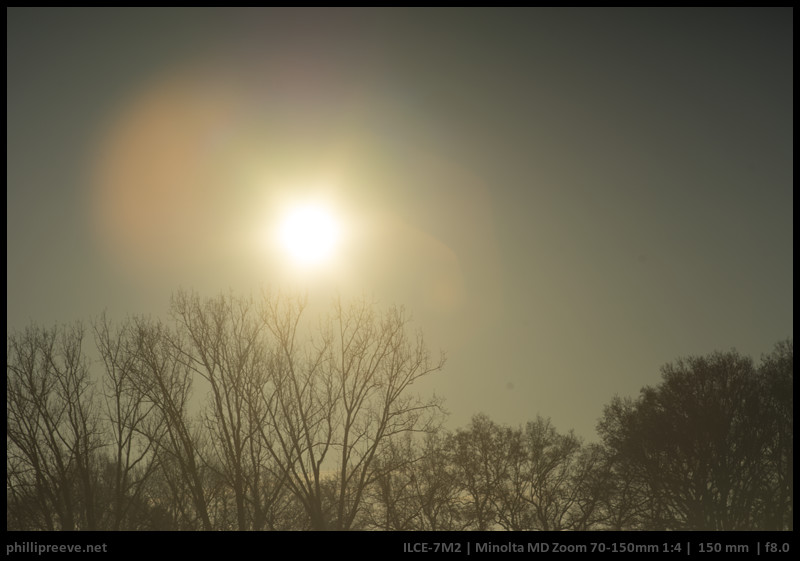

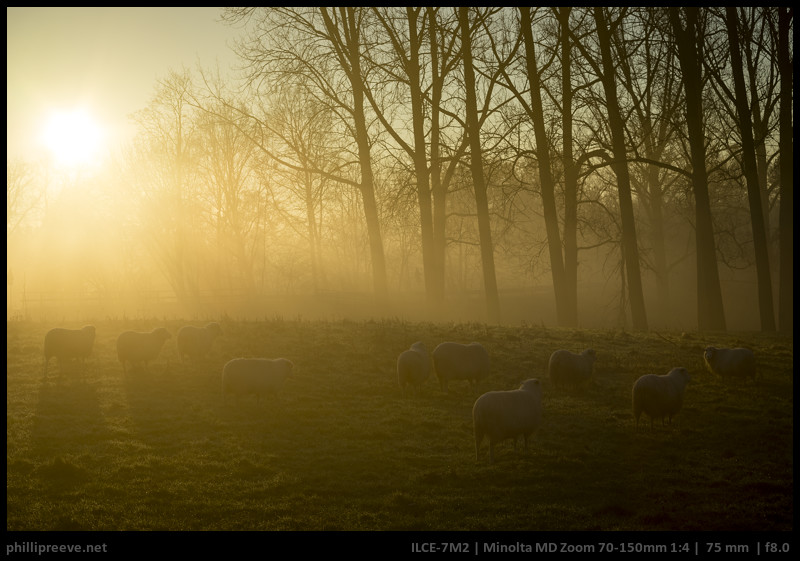
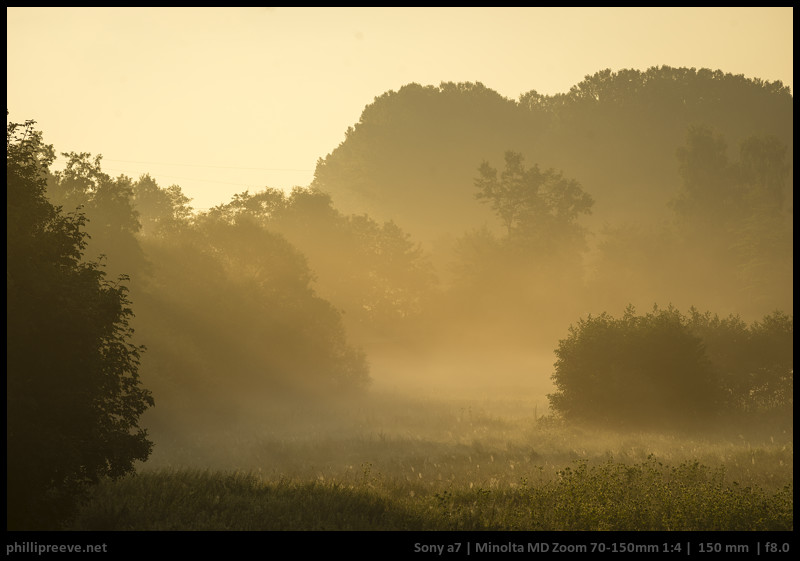

Sunstars
The Minolta has only 6 aperture blades and therefore yield 6 pointed sunstars which aren’t well defined even at f/11.
Bokeh
Since this isn’t the most important aspect for this lens I won’t go into detail too far but the Minolta’s bokeh is generally smooth with noticeable cat’s eyes and oof-highlights become hexagonal from f/5.6.

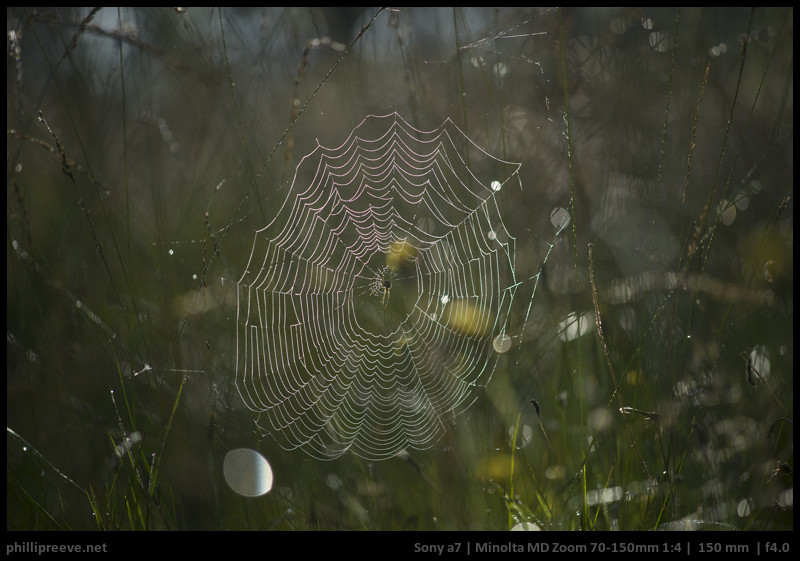

Chromatic Aberrations
The Minolta doesn’t use any ED-glass so it isn’t surprising that it’s CA correction isn’t great. It is still ahead of most legacy lenses but it will be visible for some critical applications.
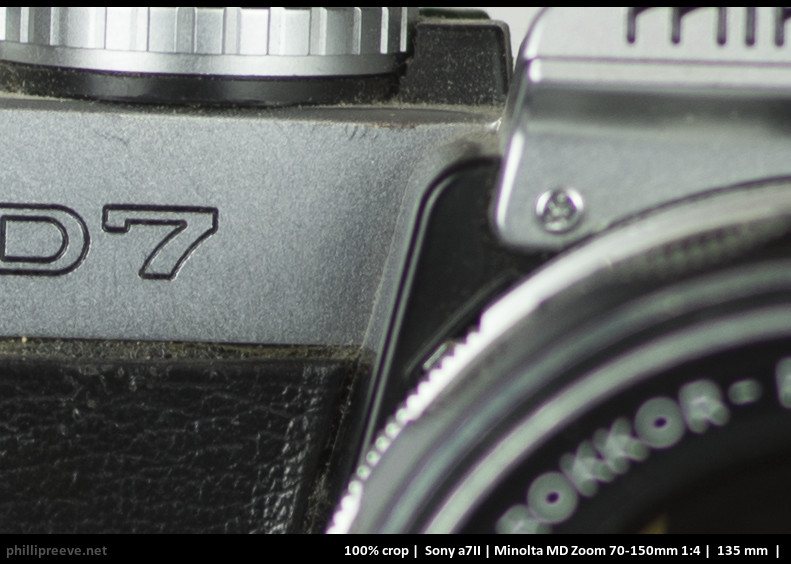
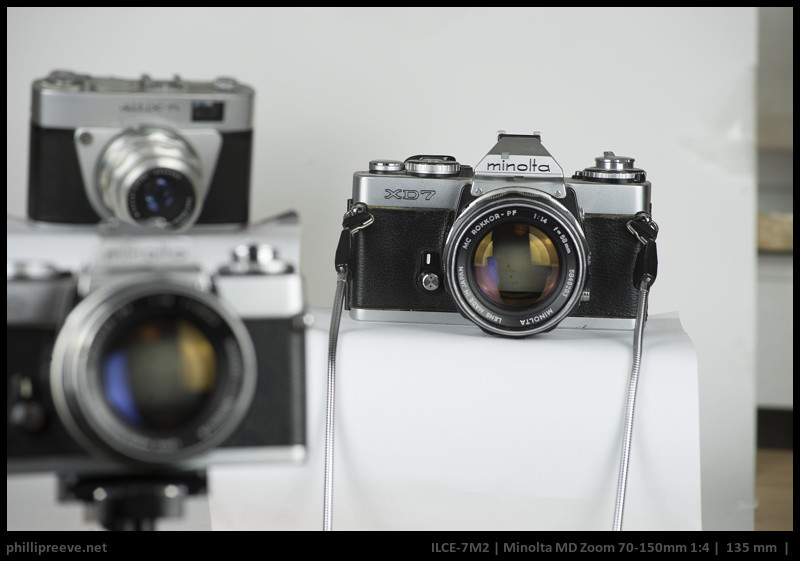
Lateral CA on the other hand are corrected really well until about 100mm but quite noticeable at 150mm.
Focus Shift
At least at short distances there is significant focus shift so one should focus at the working distance.
Vignetting
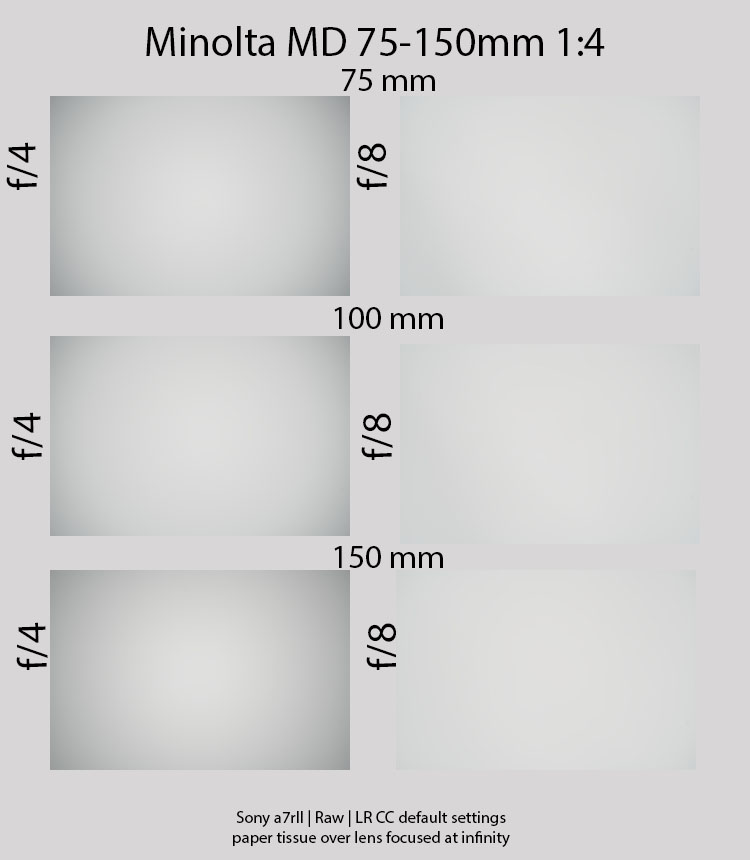
Vignetting is strongest at the long end with moderate 1.4 stops which are reduced to negligible 0.3 stops at f/8.
Distortion
The Minolta 4/75-150 shows little to strong distortion depending on the focal length. At 75mm we see significant barrel distortion which needs about an value of 8 to be corrected in LR. At 100mm there is very little distortion. At 150mm We see strong pincushion distortion which needs -7 to be corrected. A typical performance for a tele zoom.
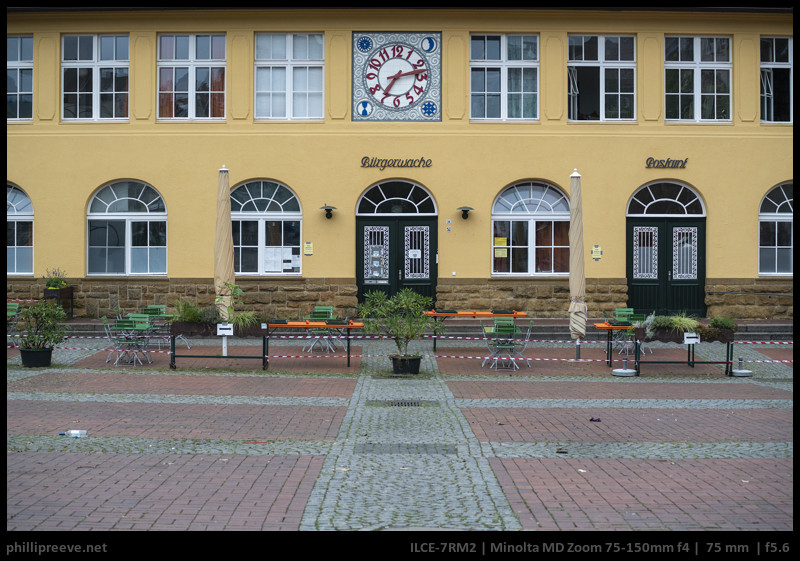
Sharpness
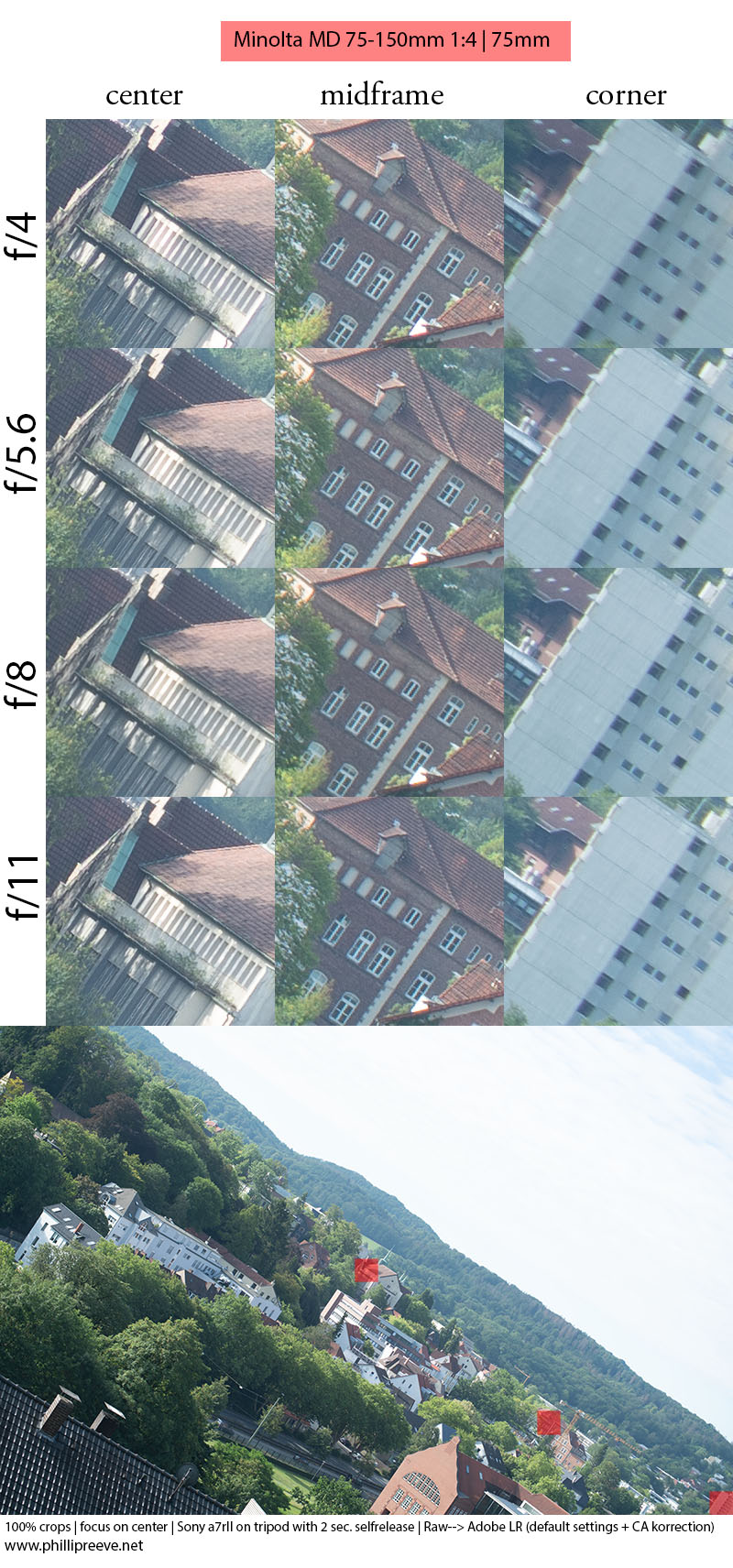
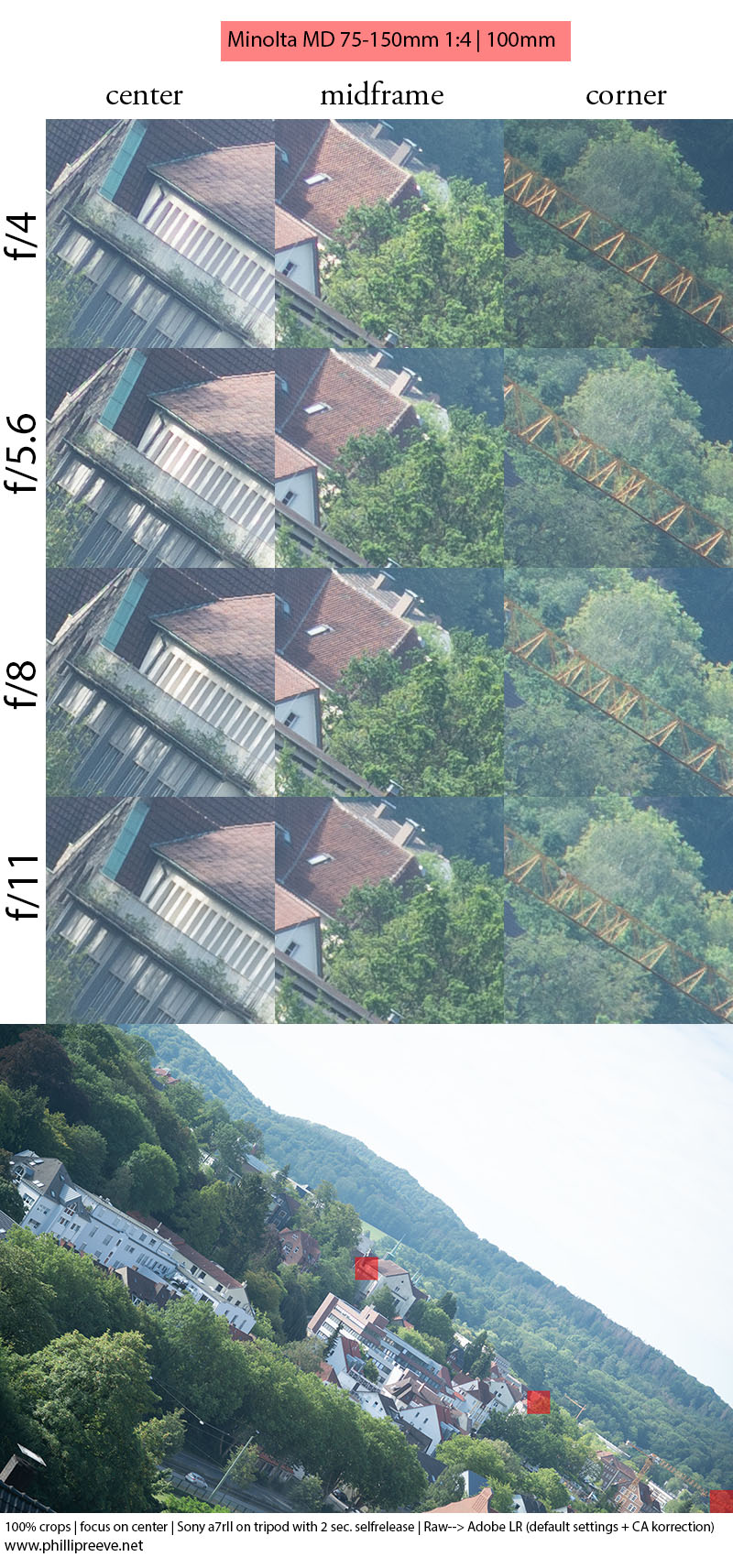
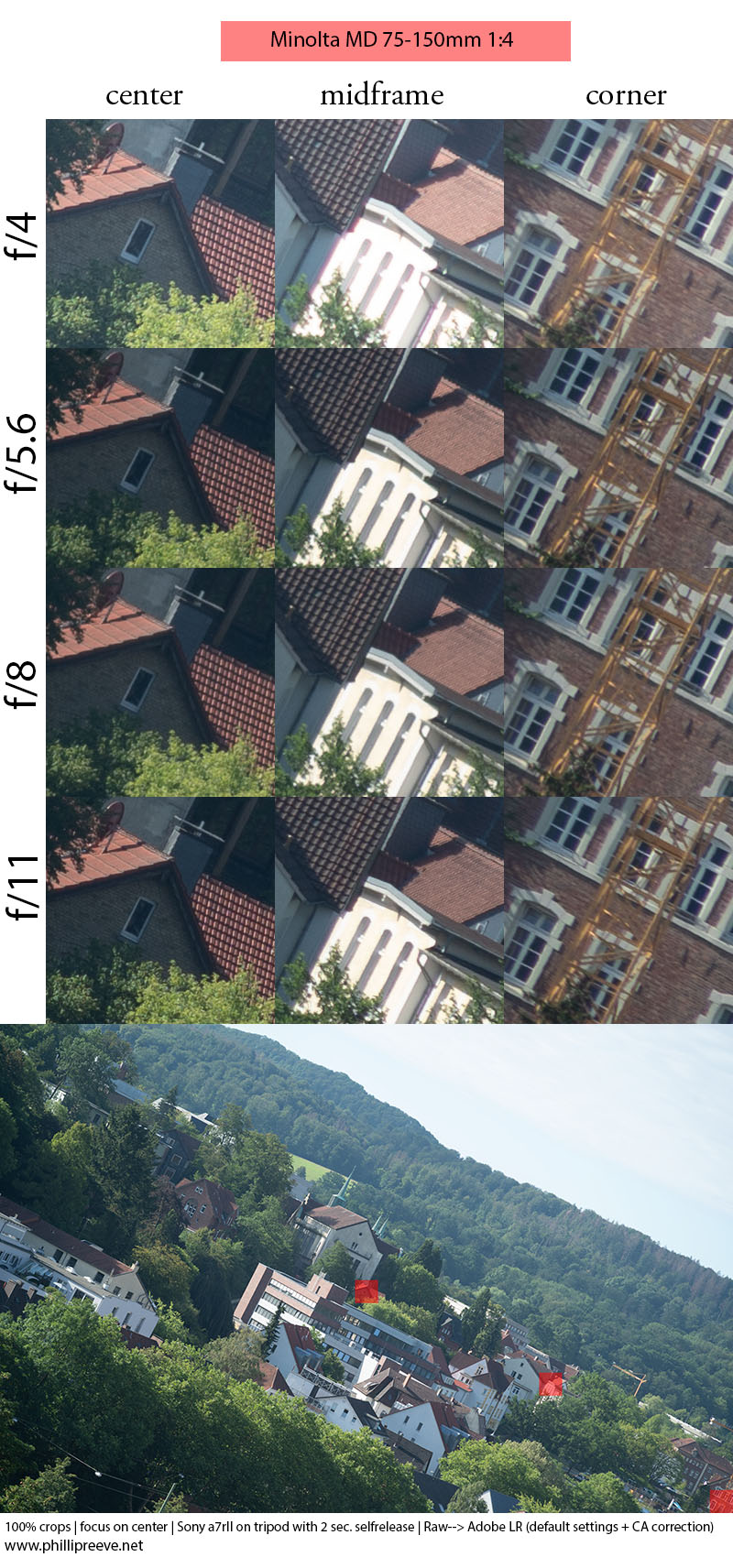
f/4: Excellent sharpness in the center across the zoom range. The midframe area is excellent as well. The corners show good sharpness.
f/5.6: A small improvement in the corners which are very good by now. Also a reduction of PF and a slight increase in contrast.
f/8: A slight decrease of center sharpness but a slight increase of corners sharpness at 75 and 100mm
f/11: The whole image is a little softer.
All in all an excellent performance for a zoom or even a prime.
Alternatives
Tamron 2.8/70-180 AF FE: As the Minolta is has a limited zoom range and it is very light for it’s speed but still nearly twice as heavy as the Minolta. It’s performance has generally been applauded for it’s very strong optical performance so it shows that a limited zoom range can be a very reasonable trade-off. While relatively affordable for a f/2.8 tele zoom it is many many times as expensive as the Minolta.
Sony FE 4/70-200: The twice as heavy and more than 10x as expensive Sony can not match the Minolta’s across the frame performance so for landscapes the Minolta could be the better alternative while the Sony of course is a lot more versatile thanks to AF and a little wider zoom range.
Canon EF 4/70-200 L USM: Similar performance as the Sony but more affordable. The big disadvantage is that it needs an adapter which makes it less attractive if it is your only EF-mount lens.
Minolta MD 2.5/100: An even lighter yet faster prime with similar image quality for those who do not put much value on the ability to zoom.
Conclusion
Strengths
- Weight and Size significantly smaller than 4/70-200 zooms
- Very good Sharpness, better than some modern zooms
- Very affordable
- Generally smooth Bokeh
Average
- Build Quality average for a lens from the 80s but very competitive by modern standards
Weaknesses
- Typically high Distortion for a zoom
- Weaker Flare Resistance than modern lenses
- Stronger LoCA than modern lenses
- Push-Pull Zoom
The Minolta MD 4/75-150 shows very good sharpness even on modern 42MP sensors, beating some modern zoom lenses 10x as expensive. It’s age shows in the below average correction of LoCA and weaker flare resistance.
While its zoom range is limited the weight of the Minolta MD 4/75-150 is very limited as well and it is much lighter than any modern zoom covering a similar zoom range. The push-pull design though is a bit of an hassle.
The Minolta MD Zoom 75-150mm 1:4 makes a very strong case for slower zooms with a limited zoom range. If a 35-years-old design without any fancy glass can outperform a modern Sony FE 4/70-200 for $1000, then I ask myself what a modern lens with similar parameters could achieve? Because of it’s parameters I would recommend it either to those who look for a very affordable tele zoom or for landscape photographers.
The Minolta MD 4/75-150 sells for around $70-100 at ebay.com or 70-90€ at ebay.de (affiliate links). If you purchase the lens through one of these affiliate-links I get a small compensation with no additional cost to you.
More Image Samples
You can find many of the images shown here in full resolution in this flickr set: Minolta MD Zoom 75-150mm 1:4.
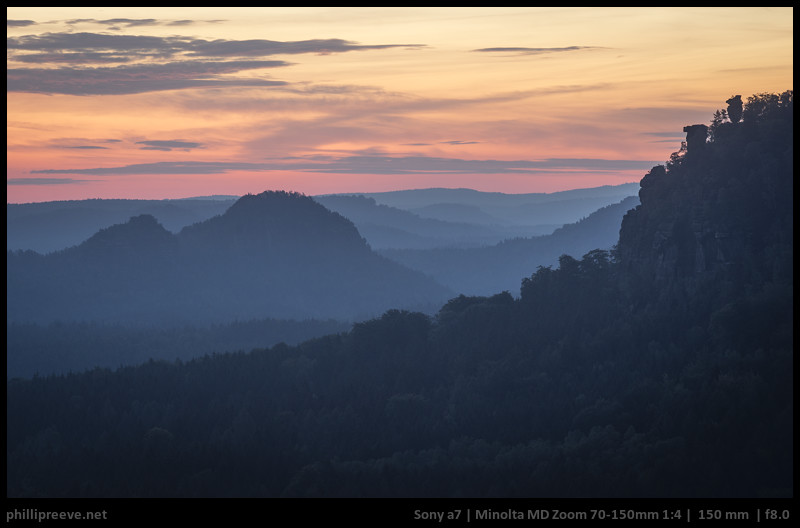
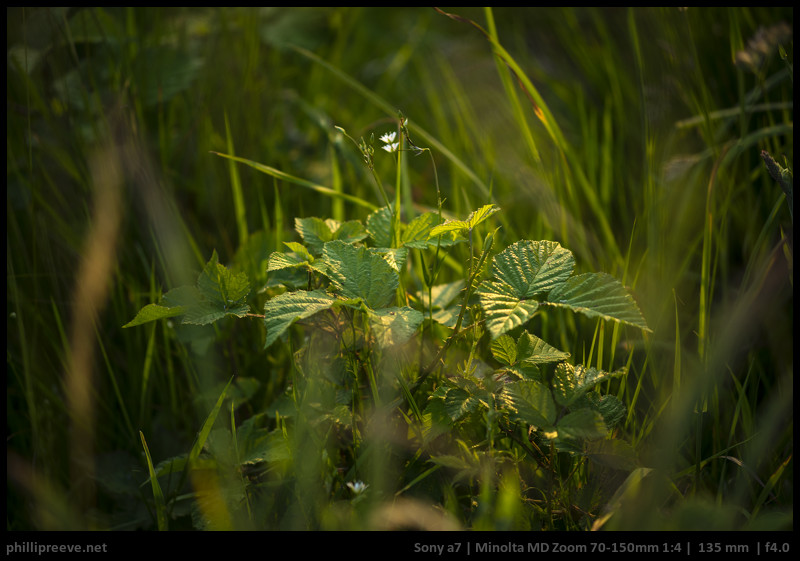
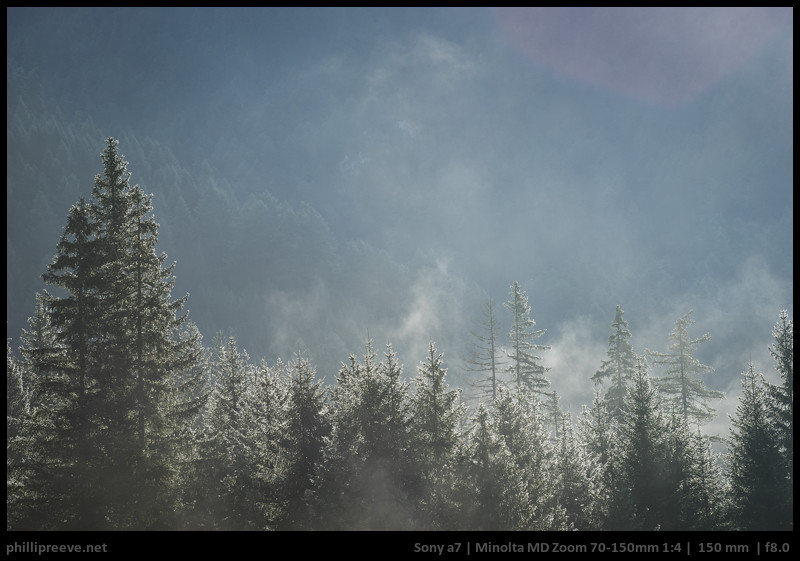
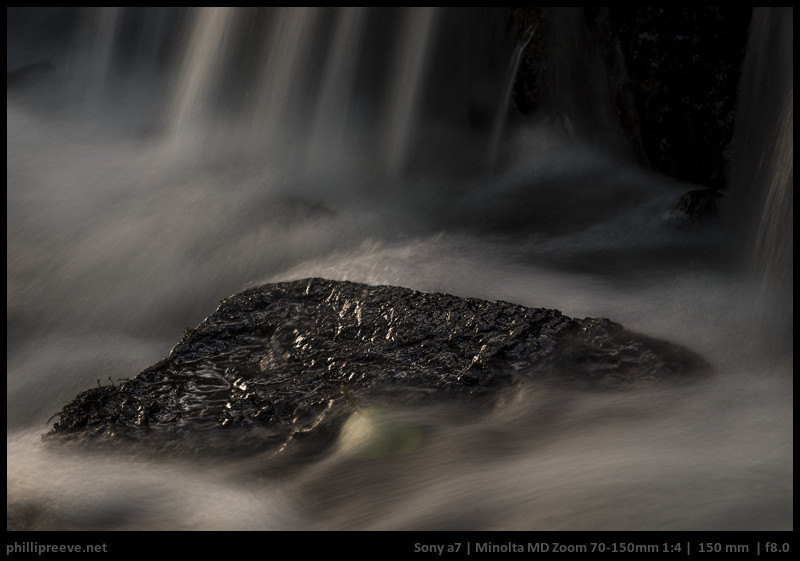
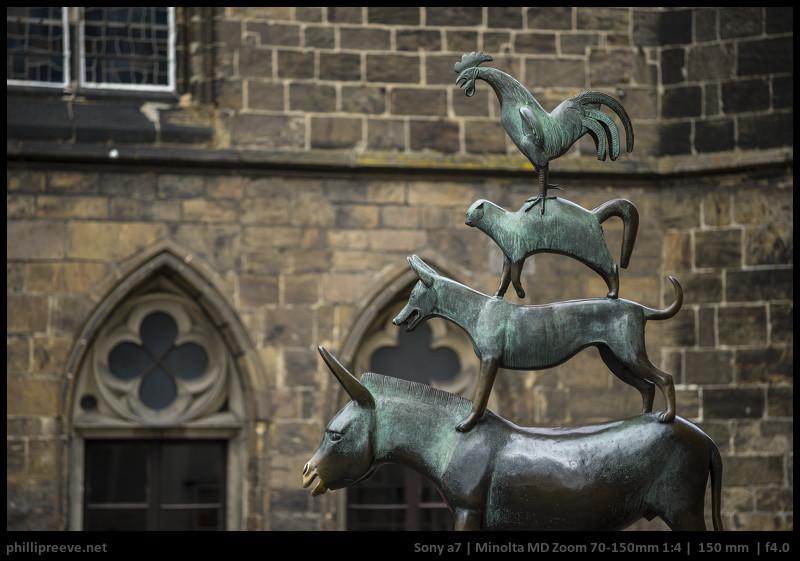
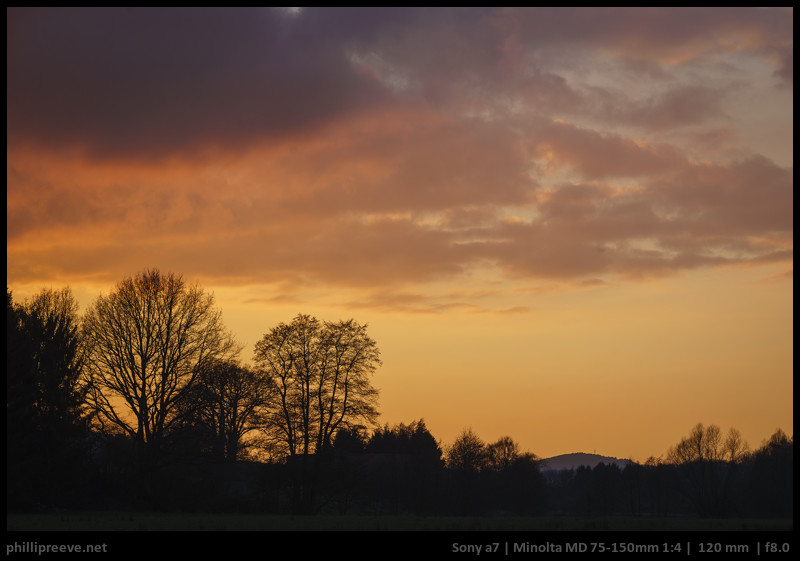
Other articles
- The rated List of Minolta MD/MC Lenses on the Sony a7
- The Best Lenses below $499 for the Sony a7 Series
- Beginner’s Guide to Manual Lenses on the Sony a7
- Sony FE lenses: A comprehensive and independent guide
- The Guide to Adapters for Minolta MC and MD lenses
This site contains affiliate links. If you make a purchase using any of the links marked as affiliate links, I may receive a small commission at no additional cost to you. This helps support the creation of future content.
Latest posts by Phillip Reeve (see all)
- Review: Samyang AF 75/1.8 FE - April 12, 2021
- The FE-List now has 113 lenses on it - March 25, 2021
- 2020 – Year’s end review - December 28, 2020



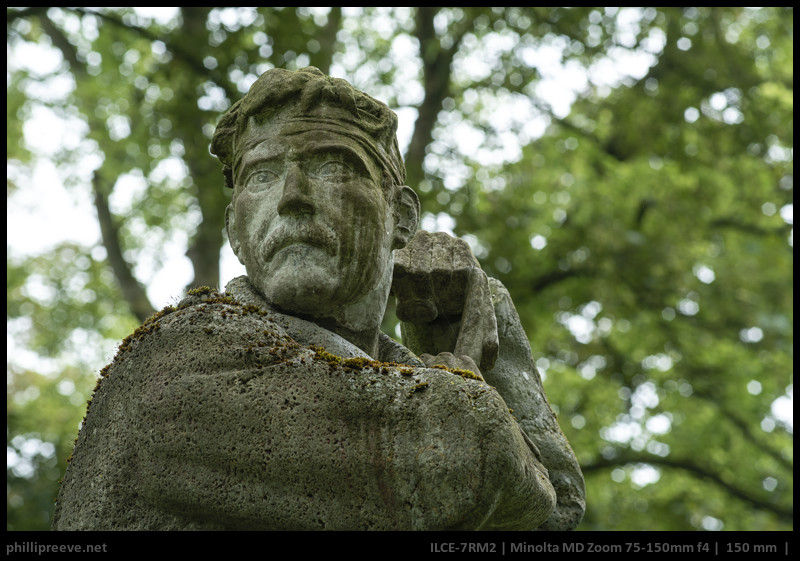

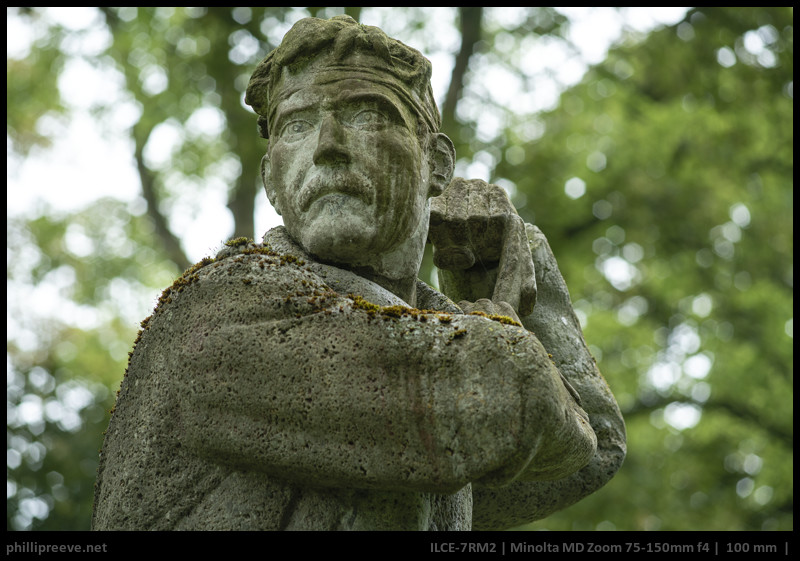


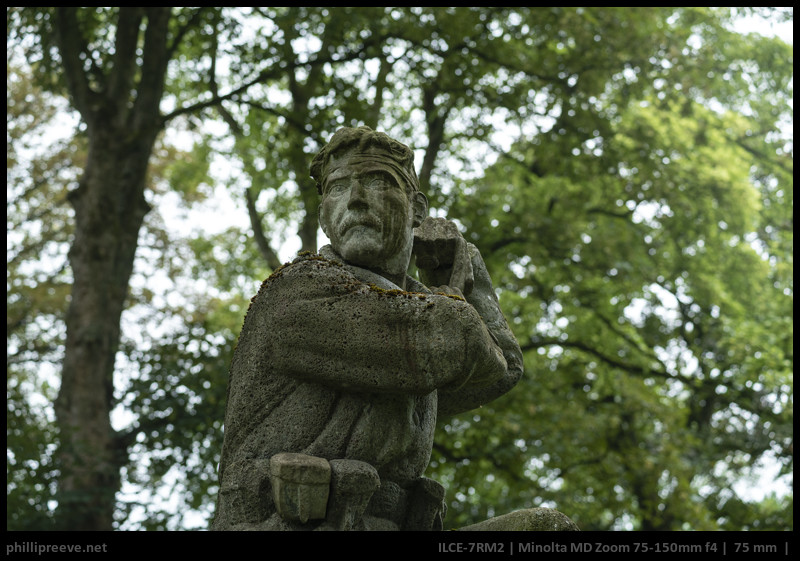


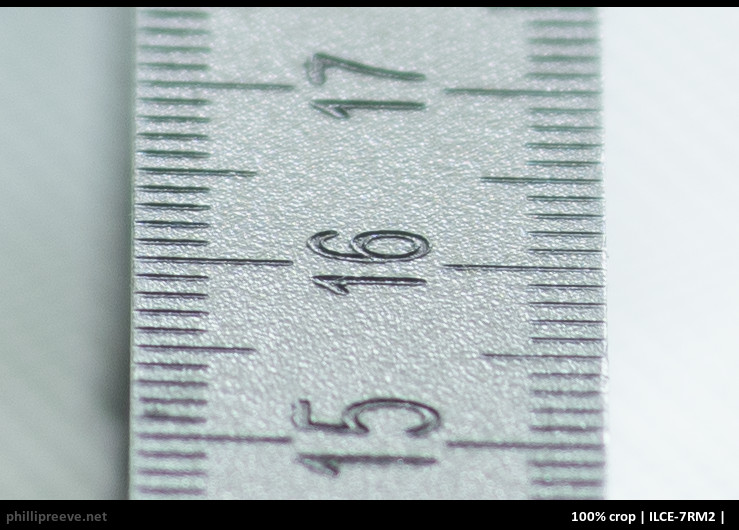




Regarding the alternatives: I think a true competitor that should be listed is the Contax-Zeiss 80-200 f4. Yes, it’s bigger (especially longer) and heavier, but balances surprisingly well on the A7III. I’m a fan of the Minolta 75-150, but the Contax has at least 4 advantages: 1) MFD of 1m – at 200mm you can get really close to your subject. 2) It has 200mm. 3) Zeiss rendering – while I really like the rendering of the Minolta, the Zeiss has that “special something”. 4) Doesn’t cost that much more than the Minolta because it’s an easy-to-find lens.
I like the 80-200 contax zeiss rendering , colors, ..
And sharpness compare the Minolta 75-150 ?
I didn’t use that Contax a lot but I think the Minolta is sharper.
seems like a great performer for the size. It’s quite hard to find though..
When considering what Tamron achieved in terms of size/weight with its new 70-180 f2.8 it seems very likely a modern f/4 2x or 3x telezoom with AF wouldnt have to be much larger than this old minolta.
It sure is a useful range, but i sold the sony 70-200 f4 since i never really took it with me much because of size.
Thanks Philip, great review. Definitely a bargain this Minolta zoom. Very affordable travel and landscape lens. I bought mine for as little as 30 EUR.
I still prefer the Elmar 4/135mm for landscape if no zoom required but the Minolta comes close. The Elmar is even smaller and lighter. Focusing is still easier for me with the Elmar. The push pull Minolta give me less keepers. I bought the Elmar for as little as 120 EUR.
I also still use the Contax 80-200mm which is better built, heavier, more PF, more tele than the Minolta. I bought it for 100 EUR.
All three lenses I would buy again and are fun to use. For a flexible light travel bag the Minolta 75-150mm is the one I take. For use with other primes the Elmar. The Contax 80-200mm if I feel I want to carry it…
Thanks Philip, great review. Definitely a bargain this Minolta zoom. Very affordable travel and landscape lens. I bought mine for as little as 30 EUR.
I still prefer the Elmar 4/135mm for landscape if no zoom required but the Minolta comes close. The Elmar is even smaller and lighter. Focusing is still easier for me with the Elmar. The push pull Minolta give me less keepers. I bought the Elmar for as little as 120 EUR.
I also still use the Contax 80-200mm which is better built, heavier, more PF, more tele than the Minolta. I bought it for 100 EUR.
All three lenses I would buy again and are fun to use. For a flexible light travel bag the Minolta 75-150mm is the one I take. For use with other primes the Elmar. The Contax 80-200mm if I feel I want to carry it…
There is also an OM Zuiko 75-150 with similar dates. How does it compare?
Seems I am not going to buy the Olympus 75-150mm:
https://www.dpreview.com/forums/post/59254227
I also own one and while its mechanics are a lot nicer optically it seems to be significantly weaker. Not that surprising since it was released in 1975 and when zooms were still a very new thing.
Phillip you bought an a7rII ? If yes, congratulations!
I like the Canon FD 80-200mm L I believe writer’s for this site have had issues but for me no problems
I used mine a lot back in the day but they are pretty expensive when they show up and mine wasn’t well centered making it less ideal for landscapes.
Here in the UK I have only ever seen one for sale (camera shops not eBay) and that was the one I purchased at £150 a few years ago.
Here a sharpness comparison with Minolta primes:
https://lens.ws/comparison-minolta-md-75-150mm-f4-0-zoom-vs-primes/
The zoom is very competitive.
Here’s another comparison I did years ago:
forum.mflenses.com/a-little-minolta-shootout-short-zooms-vs-short-primes-t75549.html
(Unfortunately, it doesn’t get displayed right with the default “Board Style”, you’d have to log in and change it to any of the others)
One thing about all these old zooms is that because of no data transmitted to the camera for focal length used, correction in post for barrel or pincushion (which varies by focal length) becomes manual and a matter of guesswork. And while one can argue that if you can’t tell/fix it “by eye”, it doesn’t really matter, still, it can. Sometimes you think something just doesn’t look right, distortion-wise, but you can’t put your finger on precisely what. Also, for stitching, you want the best distortion correction possible.
thats a good point!
also i’d like to add that while IBIS is pretty helpful in a telezoom, everytime you zoom with legacy lenses you have to change the focal length in camera manually, making IBIS kind of useless.
But i guess Philipp and most other people here would be looking at this lens for shooting landscapes exclusively, where you either have plenty of time or are using a tripod.
Great Review as always! I wonder wether you guys are planning a Review of the Tamron 70-180?
So far none of us has that lens on the shopping list, therefore you should not expect a review too soon.
Bastian, a reminder on 300 PF 🙂
I bought a Commlite CM-ENF-E1 Pro today, so reviewing that lens becomes a possibility 😉
The Olympus 75-150mm is a very weak performer; in fact it’s one of the worst lenses (out of >700) i have ever tested (apart from pre-computer age lenses, of course). I have tested two copies of the Oly 75-150mm; both did have the same issues.
The Nikon E 3.5/75-150mm is a bit faster and generally not as sharp as the Minolta 4/75-150mm. However, at it’s long end it has a rendering well suited for portraiture (good detail, relatively low contrast wide open, smooth bokeh).
The Canon nFD 4.5/70-150mm is even slower than the Minolta, and quite a bit larger! It is a stunning performer as well, certainly as good as the Minolta. I have seen several copies with fungus, so be aware of that if you want to buy the Canon nFD!
Stephan / http://www.artaphot.ch
I had this lens for a short time and thought it performed pretty well, but I really disliked the push/pull design. Thanks for doing a full review of it, it’s refreshing to see some good legacy lens reviews on this site.
Nice and honest review!
I have got this lens ages ago from Grainlab for 40€ in a mint condition.
I was very surprised to see how sharp this lens is and how the form factor is an advantage if you want to travel “light”.
On my side, the push/pull design was the selling point as I like this “old school” lens design.
What about $20 Minolta 70-210mm f4 beercan? 🙂
https://en.wikipedia.org/wiki/Minolta_AF_Zoom_70-210mm_f/4
https://www.flickr.com/groups/1494417@N20/pool/
None of us wants to deal with the LA-EA4 adapter which is necessary to have autofocus with this lens.
Not as good and much bigger.
Sadly md zoom 70-210f4 does not appear to have the same degree of sharpness.
https://lens.ws/minolta-md-70-210mm-f4-0-zoom/
md 75-200mm f4.5 is less known but at least my copy
deserves a description a stack of primes; it has the AC coating, so I expect a good amount of a copy to copy variation due to aging.
The MD 70-210 F4 and 75-200 F4.5 are pretty similar in my experience. Minolta released a crazy amount of MF zooms in the early 1980’s including two different 35-105 F3.5-4.5s a year apart.
Hello Philip, I’m a big fan of the minolta MD III series. I like the design and handling a lot more than the previous MC / MD versions. Thanks for testing a lens from this series again. My copy of the 75-150mm matches your test. A great telephoto zoom. I don’t use it often because there are many alternatives in this focal range. Also from Minolta. I love the MD III 85/2 and the 100 / 2.5. My copy of the 85s is a wonderful landscape lens. An insane resolution for such a small lens and it fits perfectly on a Sony camera.
thanks for this review, I did not know of this lens at all.
It will be a nice “compact” companion for landscapes 🙂
The weight and size of modern lenses just make me nuts !
My collection : (on Sony A7)
– Sigma super-wide II 24/2.8 (FD mount)
– Canon EF 28/2.8
– Voigtlander ultron 35/1.7 (ltm mount)
– Jupiter 3 50/1.5 of 1962 (ltm mount)
– Canon EF 85/1.8
I was firstly a Canon FD user, then went LTM with rangefinders. Ended up using digital with Canon EF and m42 lenses. My final switch was to the Sony A7 for the compact size and weight. No regrets 🙂
Keep up the good work !
Thanks and good light!
I “collected” one a while back based upon snippets of info written on this site. I found it mixed in with a bunch of cheap no-name lenses for next to nothing $ wise, never used it as most of my shots are at 35mm.
This article reminded me to pull it out and to try it out, I only wish that I was as good of a photographer as is Phillip.
Thanks!!!!!
Lucky you 🙂
This lens can be hard to find. A much cheaper and easier to find option is the Vivitar 70-150mm F3.8. Not quite as good as the Minolta but way easier to find, is a lot cheaper and is a similar size. Supposedly the same design as the Nikon Series E 75-150 but without the same zoom creep issues (Kiron made both lenses – though there’s a Tokina version apparently as well). I have it for Minolta SR mount and it’s a nice small zoom. Plenty sharp though it as CA issues wide open.
I have had both Kino 70-150/3.8s and the Tokina. My best Kino copy is very good and even smaller than the Minolta.
Has to be Filter Thread size of 49mm, Not 59 like in the article, Right?
thank you for the enlightening review! This one could maybe make it in my backpacking setup. Always had a soft spot for the minolta lenses.
Thanks for the review – after a long time a review of affordable “old glass” – I’d like to have this for my Minolta set. It’s surely great on film too.
Unfortunately it’s quite rare.
It seems I hadn’t realized how rare it is 🙁
There were a number of ~ 70-150 lenses:
http://forum.mflenses.com/whats-the-best-75-150mm-zoom-lens-t75397.html
As far as I know, the Minolta and the Canon nFD 70-150/4.5 were the best of the bunch.
The Canon is still cheap and much easier to find.
I bought one last year from Japan ( slighly more expensive than what is mentionned here) but i really really enjoy it!!!
After the 50mm f2 and 100mm f2,5 mentionned here before, i really start to find some minolta lenses attractive
(Only the 135 f2,8 was disapointting as really subject to flare and not sharp, sold it)
I just get the 28mm 3,5 and think it is underrated for 30/50euros ( i find it sharp)
Interesting!
Did you have a chance to try the Minolta AF 4,5/100-200mm? Also very small and compact, but a bit more on the longer side (and sharper than the beercan 4/70-210 on the long end). Of course manual focusing is not a joy with the AF lenses…
I used one 10 years ago with the a100 but handling on E-mount would be too much hassle to me, even if performance was on the same level as that of the 75-150.
Out of the 50 classic lenses I use (and hundreds I tried), this is my only zoom lens. It ticks all the boxes for me. Because it ‘only’ goes to 150mm, it’s still nice and compact. Because it is so sharp, you can easily crop when needed.
This one is missing from the list on the Minolta reviews page. It’s still as relevant (I just bought one from German eBay, finally…).
Fixed